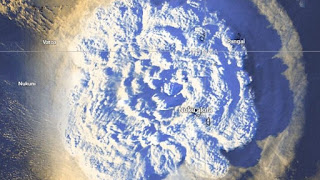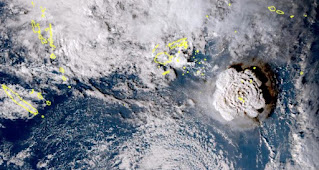The Tonga Volcano Has The Biggest Plume Ever Recorded
Using pictures captured by satellites, researchers determined that the January 2022 eruption of the hour anglenga Tonga Hungah Ha volcano made the biggest plume ever recorded.
It had been the primary direct observation that an enormous eruption penetrated the layer layer of the atmosphere.
On fifteen January 2022, Hunga Tonga Hunga Hapai, a submarine volcano within the Tongan terra firma within the Pacific Ocean, erupted violently. The explosion was the foremost powerful ever determined. sent shock waves round the world and triggered devastating tsunamis that left thousands homeless.
.jpg)
The height of a volcanic plume may be calculable by measure the temperature recorded at the highest, sometimes by infrared-based satellites, and comparison this to a reference vertical temperature profile. this is often as a result of within the layer - the primary and lowest layer of Earth's atmosphere - the temperature decreases with height. however this technique becomes general if the eruption is therefore massive that the plume penetrates succeeding layer of the atmosphere—the layer. this is often as a result of the temperature starts to rise once more with altitude- as a result of the ozonosphere absorbs star ultraviolet light.
To overcome this downside, the researchers used optical phenomenon result. it's the visible distinction within the position of Associate in Nursing object once viewed from many lines. you'll see this for yourself by holding up one hand together with your right eye closed and thumb up. If you turn eyes together with your left closed and your right open your thumb can seem to maneuver slightly into the background.
 The Tonga Volcano is roofed by 3 fixed weather satellites. therefore the researchers were ready to apply the optical phenomenon result to the aerial pictures. The satellites record pictures each ten minutes, particularly throughout the eruption itself. permitting fast changes within the mechanical phenomenon of the plume to be recorded.
The Tonga Volcano is roofed by 3 fixed weather satellites. therefore the researchers were ready to apply the optical phenomenon result to the aerial pictures. The satellites record pictures each ten minutes, particularly throughout the eruption itself. permitting fast changes within the mechanical phenomenon of the plume to be recorded.The results showed that the plume reached a most height of fifty seven kilometre. this is often considerably quite the previous record holders. The 1991 eruption of volcano within the Philippines was forty kilometre at its highest purpose and also the 1982 eruption of El Chichon in North American country was thirty one kilometre. this is often the primary data-based proof of a eruption passing through the layer and directly into the layer. It starts at Associate in Nursing altitude of fifty kilometre on top of the surface of the world.
 Lead author Dr Simon happy with the University of Oxford, RAL area and also the National Center for Earth Observation said: "This is Associate in Nursing uncommon result as we've ne'er seen a cloud of this kind before. and also the ability to estimate altitude the manner we have a tendency to do exploitation the optical phenomenon technique is simply doable as a result of we have a tendency to currently have sensible satellite coverage.
Lead author Dr Simon happy with the University of Oxford, RAL area and also the National Center for Earth Observation said: "This is Associate in Nursing uncommon result as we've ne'er seen a cloud of this kind before. and also the ability to estimate altitude the manner we have a tendency to do exploitation the optical phenomenon technique is simply doable as a result of we have a tendency to currently have sensible satellite coverage.Oxford researchers currently hope to create an automatic system to calculate the heights of volcanic plumes exploitation the optical phenomenon technique. author Dr Saint Andrew Prata from the region, Oceanic & Planetary Physics Sub-Department adscititious that we would like to use this technique to different eruptions furthermore. a lot of Science queries we would like to grasp Why did the Tonga plume go therefore high? what is going to be the region effects of this eruption? And what precisely is that the plume composed of?'
Story Source:
Materials provided by University of Oxford.
Note: Content may be changed for vogue and length.
Know Looking Back at the Tanga Eruption
Visit Official Home Page





0 Comments